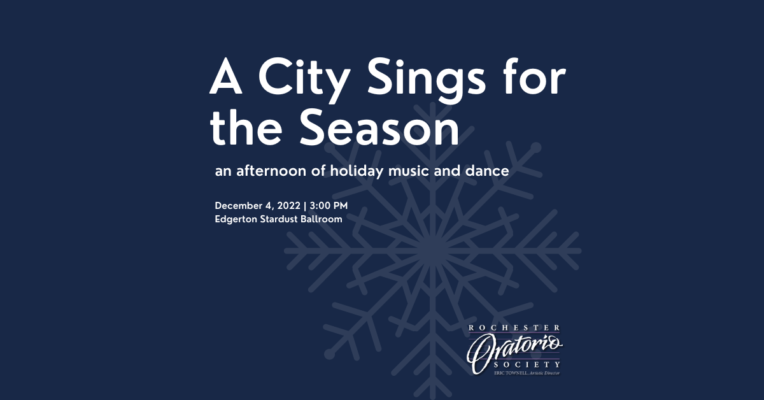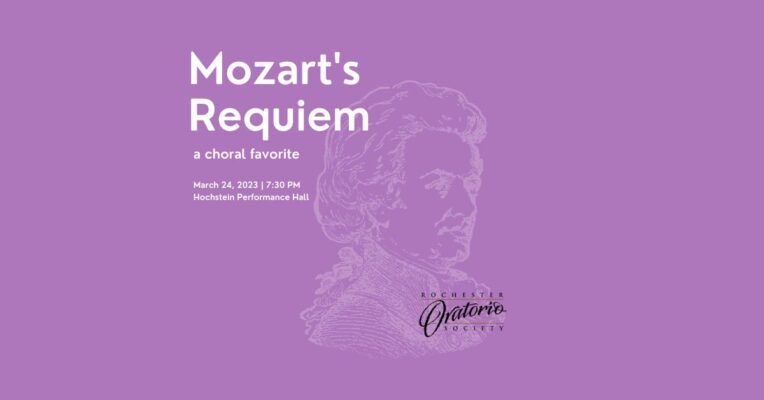Mozart’s Requiem
March 24, 2023, 7:30 PM
Hochstein Performance Hall
The Rochester Oratorio Society Chorus and Orchestra
Kevin Nitsch, Accompanist
David Hult, Concertmaster
Eric Townell, Conductor
Soloists
Meredith Hart, Tania Beghini, Amy Ewell, Paulette Gissendanner, soprano
Riley Blaakman, Sarah Engel, Lois Johnson, alto
Alex Nick, tenor
Francois Bessing, bass
Anton Bruckner (1824-1896)
Locus iste
Os justi
Libera me
W.A. Mozart (1756-1791) Requiem, K. 626
I. Introitus
a. Requiem aeternam
II. Kyrie
III. Sequentia
a. Dies irae
b. Tuba mirum
c. Rex tremendae
d. Recordare
e. Confutatis
f. Lacrymosa
IV. Offertorium
a. Domine Jesu
b. Hostias
V. Sanctus
VI. Benedictus
VII. Agnus Dei
VII. Communio
a. Lux aeterna
b. Cum sanctis tuis
Table of Contents
In Memoriam
In Memory of |
Honored by |
| Ken Anderson | Jenny Horn |
| Anne L. Bailey | Paulette Gissendanner |
| Mrs. Ruth E. Beaver | Skip Beaver |
| Mr. David Beaver | Skip Beaver |
| Mary Blaakman | Riley Blaakman |
| Frank, Jane, and Timothy Bryant | Susan Woodhouse |
| Bishop Matthew H. Clark | Mary Ellen Coleman |
| Elaine A. Clark | Katherine Clark Walter |
| Gerry Cooke | Jen Cheney |
| Laurie Cooke | Jen Cheney |
| Andrew R. DeLapp | Tania Beghini |
| Cosmo Dell’Anno | Simone Picciolo |
| Thomas Elliott | Carol Elliott |
| Colin Fink | Nancy Fink |
| Ruth Fitzgerald | Dorothy Needler |
| Peggy Fosh | C Denise Yarbrough |
| Jon Fox | Tania Beghini |
| Cindy Gray | Jen Cheney |
| Ralph Gurnther | Peter Gaess |
| Adolfine and Frederick Hellwig | Harry Hellwig |
| Ergün Karaoguz | Sue Lione |
| Maxim Alexander Koski | Nina Koski |
| Ha Ching Ma | Grace Leung |
| Lai Ying Ma | Grace Leung |
| Marjorie McMahon | Caitlin Maeder |
| Katie McNally | Donna Budgeon |
| Katie McNally | Jenny Horn |
| Katie McNally | Sandy Moncrief |
| Mary Lewis Meconi | Honey Meconi |
| Raymond and Jean Miller | Nancy Schreiber |
| Bob Moore | Jenny Horn |
| Bob Moore | Sandy Moncrief |
| Alfonso C. Nazzaro | Mary Ann Nazzaro |
| Michael O’Connor | Robert & Annette Leopard |
| Matthew Pagani | Lisa de Blieck |
| Ann Parsons | Elise Rosenfeld |
| Linda Payne | Sarah Stage |
| Luigi and Caterina Picciolo | Simone Picciolo |
| Pati Piper | Katherine Clark Walter |
| Pati Piper | Paulette Gissendanner |
| Pati Piper | Lilith Hart |
| Richard Powers | Ann Robinson |
| ROS recently deceased board and singing members | Sue Geier |
| Wiley Robinson | Ann Robinson |
| Sylvia Rosello | Jen Cheney |
| Peter Rulison | Robert & Annette Leopard |
| Donna Salmon | Nancy Schreiber |
| Beverly Sanford | Ann Robinson |
| Martin and Rita Schreiber | Nancy Schreiber |
| George A. Schutt | Skip Beaver |
| Marick J. Schwartz | Amy Ewell |
| Christian E. Seitz | Jenny Horn |
| Jeffrey P. Slon | Bob Slon |
| JoAn and William Stein | Barbara Hellwig |
| Fred and Ilse Stern | Sue Geier |
| Virginia Thompson Gilman | Andrea Gilman |
| Jane Thompson Southgate | Andrea Gilman |
| Phyllis Van As Arnold | Patricia Van Dussen |
| Jaap van Benthem | Honey Meconi |
| John Van Dussen | Patricia Van Dussen |
| Sue White | Ted White |
| Roger Wilhelm | Bob Slon |
| Peter Yackel | Dorothy Needler |
| Ellen K. Zimmermann | Maryellen Giese |
Texts and Translations
Anton Bruckner
Locus iste
Locus iste a Deo factus est, inaestimabile sacramentum, irreprehensibilis est.
This place was made by God, a priceless sacrament; it is without reproach.
Os justi
Os justi meditabitur sapientiam: et lingua eius loquetur judicium. Lex Dei ejus in corde ipsius: et non supplantabuntur gressus ejus. Alleluia.
The mouth of the righteous utters wisdom,and his tongue speaks what is just. The law of his God is in his heart: and his feet do not falter. Alleluia
Libera me
Libera me, Domine, de morte æterna, in die illa tremenda quando cœli movendi sunt et terra dum veneris iudicare sæculum per ignem. Tremens factus sum ego, et timeo, dum discussio venerit, atque ventura ira quando cœli movendi sunt et terra. Dies illa, dies iræ, calamitatis et miseriæ, dies magna et amara valde dum veneris iudicare sæculum per ignem. Requiem æternam dona eis, Domine: et lux perpetua luceat eis.
Deliver me, O Lord, from death eternal on that fearful day,When the heavens and the earth shall be moved,When thou shalt come to judge the world by fire.I am made to tremble, and I fear, till the judgment be upon us, and the coming wrath, when the heavens and the earth shall be moved. That day, day of wrath, calamity and misery, day of great and exceeding bitterness,when thou shalt come to judge the world by fire. Rest eternal grant unto them, O Lord, and let light perpetual shine upon them.
W.A. Mozart
Requiem, K. 626
I. Introit: Requiem
Requiem aeternam dona eis, Domine, et lux perpetua luceat eis. Te decet hymnus, Deus, in Sion, et tibi reddetur votum in Jerusalem. Exaudi orationem meam, ad te omnis caro veniet. Requiem aeternam dona eis, Domine, et lux perpetua luceat eis.
Grant them eternal rest, Lord, and let perpetual light shine on them. You are praised, God, in Zion, and homage will be paid to You in Jerusalem. Hear my prayer, to You all flesh will come. Grant them eternal rest, Lord, and let perpetual light shine on them.
II. Kyrie
Kyrie, eleison. Christe, eleison. Kyrie, eleison.
Lord, have mercy on us. Christ, have mercy on us. Lord, have mercy on us.
III. Sequence
a. Dies irae
Dies irae, dies illa Solvet saeclum in favilla, teste David cum Sibylla. Quantus tremor est futurus, quando judex est venturus, cuncta stricte discussurus!
Day of wrath, day of anger will dissolve the world in ashes, as foretold by David and the Sibyl. Great trembling there will be when the Judge descends from heaven to examine all things closely.
b. Tuba mirum
Tuba mirum spargens sonum per sepulchra regionum, coget omnes ante thronum. Mors stupebit et natura, cum resurget creatura, judicanti responsura. Liber scriptus proferetur, in quo totum continetur, unde mundus judicetur. Judex ergo cum sedebit, quidquid latet, apparebit, nil inultum remanebit. Quid sum miser tunc dicturus? quem patronum rogaturus, cum vix justus sit securus?
The trumpet will send its wondrous sound throughout earth’s sepulchers and gather all before the throne. Death and nature will be astounded, when all creation rises again, to answer the judgment. A book will be brought forth, in which all will be written, by which the world will be judged. When the judge takes his place, what is hidden will be revealed, nothing will remain unavenged. What shall a wretch like me say? Who shall intercede for me, when the just ones need mercy?
c. Rex tremendae
Rex tremendae majestatis, qui salvandos salvas gratis, salve me, fons pietatis.
King of tremendous majesty, who freely saves those worthy ones, save me, source of mercy.
d. Recordare
Recordare, Jesu pie, quod sum causa tuae viae; ne me perdas illa die. Quaerens me, sedisti lassus, redemisti crucem passus; tantus labor non sit cassus. Juste judex ultionis, donum fac remissionis ante diem rationis. Ingemisco, tamquam reus: culpa rubet vultus meus; supplicanti parce, Deus. Qui Mariam absolvisti, et latronem exaudisti, mihi quoque spem dedisti. Preces meae non sunt dignae, sed tu, bonus, fac benigne, ne perenni cremer igne. Inter oves locum praesta, Et ab haedis me sequestra, Statuens in parte dextra.
Remember, kind Jesus, my salvation caused your suffering; do not forsake me on that day. Faint and weary you have sought me, redeemed me, suffering on the cross; may such great effort not be in vain. Righteous judge of vengeance, grant me the gift of absolution before the day of retribution. I moan as one who is guilty: owning my shame with a red face; suppliant before you, Lord. You, who absolved Mary, and listened to the thief, give me hope also. My prayers are unworthy, but, good Lord, have mercy, and rescue me from eternal fire. Provide me a place among the sheep, and separate me from the goats, guiding me to Your right hand.
e. Confutatis
Confutatis maledictis, flammis acribus addictis, voca me cum benedictus. Oro supplex et acclinis, cor contritum quasi cinis, gere curam mei finis.
When the accused are confounded, and doomed to flames of woe, call me among the blessed. I kneel with a submissive heart, my contrition is like ashes, help me in my final condition.
f. Lacrimosa
Lacrimosa dies illa, qua resurget ex favilla judicandus homo reus. Huic ergo parce, Deus, pie Jesu Domine, dona eis requiem. Amen.
That day of tears and mourning, when from the ashes shall arise, all humanity to be judged. Spare us by your mercy, Lord, gentle Lord Jesus, grant them eternal rest. Amen.
IV. Offertory
a. Domine Jesu
Domine Jesu Christe, Rex gloriae, libera animas omnium fidelium defunctorum de poenis inferni et de profundo lacu. Libera eas de ore leonis, ne absorbeat eas tartarus, ne cadant in obscurum. Sed signifer sanctus Michael repraesentet eas in lucem sanctam. Quam olim Abrahae promisisti et semini ejus.
Lord Jesus Christ, King of glory, liberate the souls of the faithful, departed from the pains of hell and from the bottomless pit. Deliver them from the lion’s mouth, lest hell swallow them up, lest they fall into darkness. Let the standard-bearer, holy Michael, bring them into holy light. Which was promised to Abraham and his descendants.
b. Hostias
Hostias et preces tibi, Domine, laudis offerimus. Tu suscipe pro animabus illis, quorum hodie memoriam facimus. Fac eas, Domine, de morte transire ad vitam, Quam olim Abrahae promisisti et semini ejus.
Sacrifices and prayers of praise, Lord, we offer to You. Receive them on behalf of those souls we commemorate today. And let them, Lord, pass from death to life, which was promised to Abraham and his descendants.
VII. Agnus Dei
Agnus Dei, qui tollis peccata mundi, dona eis requiem. Agnus Dei, qui tollis peccata mundi, dona eis requiem. Agnus Dei, qui tollis peccata mundi, dona eis requiem sempiternam.
Lamb of God, who takes away the sins of the world, grant them eternal rest. Lamb of God, who takes away the sins of the world, grant them eternal rest. Lamb of God, who takes away the sins of the world, grant them eternal rest forever.
VIII. Communio
a. Lux aeterna
Lux aeterna luceat eis, Domine, cum sanctis tuis in aeternum, quia pius es. Requiem aeternam dona eis, Domine, et Lux perpetua luceat eis, cum sanctis tuis in aeternum, quia pius es.
Let eternal light shine on them, Lord, as with Your saints in eternity, because You are merciful. Grant them eternal rest, Lord, and let perpetual light shine on them, as with Your saints in eternity, because You are merciful.
Program Notes
by Honey Meconi
Bruckner
Bruckner is probably best known for his massive symphonies, but sacred choral music played an important role throughout his life—not surprisingly, given his employment for many years at the August
inian monastery of St. Florian and then Linz Cathedral. His best-known large-scale choral works are the Te deum and the masses in D minor, E minor, and F minor, but his many small motets are gems of the choral repertoire. Locus iste was written in 1869 for the dedication of the votive chapel in the Linz Cathedral, and the short text is taken appropriately from the Gradual of the mass for dedication of a church. The music is relatively straightforward, but it is nonetheless powerful. The piece is for unaccompanied SATB chorus, with an A B A’ formal structure. The opening section (Locus iste a Deo factus est) is in a clear C major; the mostly syllabic text setting and use of homorhythm, along with the a cappella texture, are nods to the contemporary Cecilian choral movement that strove for Palestrina-like writing in sacred music. The central B section, however, is pure Bruckner, with its use of imitation, shifting tonal center, and especially sequence, first rising (inaestimabile sacramentum) and then falling (irreprehensibilis est). A poignant half measure of silence leads to a varied return of the opening text and music. For obvious reasons, it is best to sing this in a cathedral acoustic, but even in a normal venue the power of Bruckner’s exquisite setting will come across.
Os justi was dedicated to Cecilianist Ignaz Traumihler, the chorus director of St. Florian, and it premiered on the liturgically appropriate date of 28 August 1879, the Feast of St. Augustine. St. Augustine was one of the theologically important Doctors of the Church, and the text used in Os justi is that of the Gradual for the mass for the common of Doctors of the Church—hence the perfect liturgical fit. The choral forces are SSAATTBB, without accompaniment, thus matching the Cecilian preference. But the more blatently Cecilian gesture is that the work is written in pure Lydian mode, which means that the pitch center is F (as in F major) but that B-natural is used instead of B-flat. Bruckner boasted to a friend that the work, in fact, uses no flats anywhere and eschews both second-inversion triads and seventh chords. This makes it all the more impressive that the composition is nonetheless interesting harmonically, building to a massive climax on “loquetur judicium” (speaks what is just) and including delicious suspensions after that (“in corde ipsius”—in his heart). Cecilian influence is present to the very end, when the chorus intones a solemn plainchant “alleluia” to
conclude this masterpiece.
Libera me is one of Bruckner’s earliest choral works, and is one of his earliest compositions overall, dating from the period 1843–1845. This rarely-heard work is his first of two settings of this text. Music lovers typically know the “Libera me” text from its use in both the Verdi and the Fauré Requiems, although it is not technically part of the mass itself. Instead, it is a responsory from the Absolution, the ceremony over the coffin after the conclusion of the mass itself. Fauré’s Libera me is mournful; Verdi’s is passionately dramatic. Bruckner’s, which predates either of those famous settings, is altogether different. Set for SATB chorus with organ accompaniment, it is in a reassuring F major. With the move to “Tremens factus,” the key modulates to Bb and then G minor, to return to F major for the concluding “Requiem aeternam.” The text setting is overwhelmingly syllabic and the texture is pervasively homorhythmic, with all voices moving together. The straightforward organ accompaniment largely doubles the vocal lines, adding to the simplicity of texture. The work is readily recognized as a youthful effort that belies the terror described in the text to focus instead on the message of the closing line via the overall gently melodious and soothing style.
For more on Bruckner and his choral works, turn to the entry in The Choral Singer’s Companion: Anton Bruckner—Choral Music :: The Choral Singer’s Companion (thechoralsingerscompanion.com)
Wolfgang Amadeus Mozart: RequiemIn the summer of 1791 a mysterious stranger approached Mozart with a commission for a Requiem mass. The commissioner, working anonymously through an intermediary, was Franz, Count von Walsegg. The Requiem was to be for his wife, who had died the previous February, and the Count intended to pass it off as his own (which he eventually did, at two performances in 1793 and 1794). Mozart worked on the score during the fall of 1791, through increasing ill health. On the afternoon of December 4 (according to one of those present, writing years later), the gravely ill composer, his wife, and several others sang through parts of the incomplete Requiem. Eleven hours later Mozart was dead. Almost immediately people began to work on finishing the composition, and on December 10 part of the Requiem was performed at a mass for Mozart. Exactly who did what to the work in the months after Mozart’s death is debated by scholars, but Mozart’s widow eventually enlisted Mozart’s pupil Franz Xaver Süssmayr (1766–1803), to complete the piece. In the twentieth century others have ventured completions: Franz Beyer, Hans-Josef Irmen, Richard Maunder, H.C. Robbins Landon, Duncan Druce, and Robert Levin. None has provided serious competition to the “Süssmayr” version for performer attention or audience love, and none is likely to. For better or worse, Süssmayr’s completion is the one that, for most music-lovers, is what is meant by the Mozart Requiem, and it is the one being performed tonight. How much Süssmayr was following Mozart’s instructions or now-lost material remains controversial and ultimately unknowable. The Süssmayr version premiered in a concert in January 1793 (note—not a liturgical service!) to benefit Mozart’s widow and children, and was published by Breitkopf & Härtel in 1800. Performing forces for the work are two basset horns, two bassoons, two trumpets, three trombones, timpani, strings, organ, SATB soloists, and SATB chorus. Note the overall dark orchestration—no flutes, oboes, clarinets—appropriate, of course, for a work of mourning. The use of trombones is appropriate as well; trombones have a long history in sacred music, plus a strong connection to the underworld. Mozart fully orchestrated the Introit for the mass, and some orchestration notes are scattered throughout the rest of the score, but most decisions on instrumentation were made by Süssmayr and others who worked on the piece. In general it is the chorus that drives the work; it is far more important than the soloists (who most often sing as a quartet), and the piece includes little purely orchestral writing. The biggest exceptions are the beginning of the Requiem and the beginning of the Recordare. Much instrumental writing is colla parte, doubling the voices; other times the orchestra provides rhythmic contrast and interest. Obbligato parts were typically added by the completion team. Mozart wrote a good deal of sacred music when he was in the employ of the Archbishop of Salzburg, though he had not composed it regularly since the move to Vienna. But he was slated to take over as Kapellmeister at St. Stephen’s Cathedral on the death of the incumbent, so he had a renewed interest in liturgical music by the time of the Requiem. He follows various mass norms of the later eighteenth century: four soloists whose music is interwoven with that of the chorus; no long solo sections or arias; three trombones playing colla parte with the ATB parts; the Sanctus split into Sanctus and Benedictus; the repeat of the Kyrie music for the final section of the Agnus. The overall layout of the mass follows that of Michael Haydn’s Requiem, which Mozart had performed while in Salzburg, and there are other Michael Haydn influences as well. The layout of the mass given below uses brackets for the parts that are in Mozart’s hand in the original manuscript. Introit (Requiem) and Kyrie: Chorus and S soloist [Mozart: full Introit; vocal parts & figured bass for Kyrie]Sequence [Mozart: vocal parts & figured bass through m. 8 of Lacrymosa]Dies irae: Chorus Tuba mirum: SATB soloists Rex tremendae: Chorus Recordare: SATB soloists Confutatis: Chorus Lacrymosa: Chorus Offertory [Mozart: vocal parts and figured bass]Domine Jesu: Chorus and SATB soloists Hostias: Chorus Sanctus Sanctus: Chorus Benedictus: SATB soloists and Chorus Agnus Dei and Communion (Lux aeterna): Chorus and S soloist INTROIT and KYRIE Mozart wrote a superlative opening for the mass, with its subdued, plodding orchestral motion of grief portrayed that bursts into trombone fortes right before the chorus’s imitative entrance. Much of the material for the Introit comes from Handel’s funeral anthem for Queen Caroline, The Ways of Zion Do Mourn, an appropriate choice for the Requiem (the main theme was also used by Florian Leopold Gassmann [1729–1774] in his Requiem, a work Mozart could easily have encountered). Once the chorus has had its imitative opening, the voices move to homorhythmic motion for “et lux perpetua.” Mozart switches to the soprano soloist for the cantabile beginning of the Introit’s psalm verse, “Te decet hymnus” (based on a plainchant melody), but he dispenses with her almost immediately and brings the chorus back to finish the psalm verse and the return of the antiphon text with the same opening subject (Introit texts follow the structure antiphon / psalm verse / antiphon). This time the imitation is heightened by the use of a more rapidly movement countersubject for “dona eis requiem,” leading to hushed homophony for “et lux perpetua luceat eis.” Here the Introit finishes, but the chorus is left holding an unresolved dominant triad. The harmonic tension is resolved only when the chorus starts the Kyrie, a strict fugue. Here again Mozart turned to Handel; the fugue subject comes from the closing chorus of the Dettingen Te Deum. The imitative subject was a popular one; it was also used for “And with his stripes” from Messiah. The fugue subject is always presented with a counter-subject (also from the Te Deum), first sung by the altos; with it Mozart juxtaposes the Kyrie and Christe texts rather than using them successively. The end of the movement is also Handelian: the breaking off of the imitative allegro music, now on an unstable diminished seventh chord, followed by an adagio homophonic close. The final sonority is an open fifth, a sound that evokes the past. From the birth of polyphony that was the sound used at the end of compositions or movements therein; only around 1500 did thirds begin to appear regularly in final sonorities. SEQUENCE Mozart divides the long text of the sequence into six sections. The “Dies irae” gets off to a dramatic start, with its forte dynamic, homorhythmic choral writing, rapid-fire syllabic text setting, and pulsing orchestral accompaniment of non-stop motion and insistent syncopations. The chorus contribute to the general mood with specific text painting on “quantus tremor est futurus,” with trembling vocal lines. The movement concludes with numerous sycopated motives. The solo trombone provides text-painting for the “Tuba mirum” movement, entrusted to the soloists, and then the chorus returns for the brief “Rex tremendae,” where the doubly-dotted rhythms call to mind the style of the French Overture, begun at the court of Louis XIV to honor that king and spread across Europe. The whispered prayer for “salva me” provides a strong contrast to close the movement. The soloists then take over for the “Recordare.” Contrast forms an important part of the “Confutatis,” where the men rage loudly in crisp dotted rhythms while the women sing softly with more delicate, cloud-like vocal lines. The calming cadential chord of F major at the end is immediately followed by a transitional chord to move us to the “Lacrymosa” that immediately follows. The tears of “Lacrymosa” are nicely evoked by the restless alternating orchestral accompaniment and choral outbursts. This section—and thus the entire sequence—ends with a simple plagal cadence, but that’s not what Mozart wanted. His sketches tell us that the plan was for a rather fancy Amen fugue here, with inversion (upside-down treatment of the subject), diminution (shortening the rhythmic values of the subject) and possibly retrograde (presenting the subject backwards). The subject itself was an inversion of the Introit subject. A fugue makes sense here; the mass’s first section (Introit/Kyrie) ends with one, the Offertory ends with one, and the final movement would be expected to end with one as well, given the normal practice of bringing back material from the beginning at the end. And Süssmayr ends the Sanctus/Benedictus with fugal material as well. This gives a coherent plan to the whole, with each of the five sections ending fugally. But it seems as if Süssmayr was probably not up to producing Mozart’s intended fugue and thus reverted to the two-chord cadence—a real disappointment to fugue lovers. OFFERTORY The Offertory brings the Requiem back to Mozart territory. It is in four sections in two movements: “Domine Jesu Christe” and “Quam olim Abrahae” in the first movement, and “Hostias” and a repeat of “Quam olim Abrahae” in the second movement. “Domine Jesu Christe” and “Hostias” have rather different characters, with a restless duple meter G minor for the former, and a lyrical triple meter Eb major for the latter. “Quam olim Abrahae” is a free fugue that uses overlapping entries of the subject; it also uses syncopation to excellent effect (“promisisti”). SANCTUS The Sanctus returns to Süssmayr; whether Mozart’s ideas, plans, or now-lost material influenced its composition is impossible to know. It is striking that, when the Osanna text returns, as it must, Süssmayr is unable to repeat the earlier Osanna exactly (the common practice) as he seems unable to move the material back to D major easily. So the second Osanna has the same imitative material as the first, but it’s rearranged and in a different key now, with entrances in TASB order rather than BTAS. AGNUS DEI and COMMUNION The last section begins with Süssmayr and ends with Mozart. As with the Introit/Kyrie, the short melody of the soprano soloist marks a new section, in this case the move to the Communion. The music moves to Mozart as well; from “Lux aeterna” on it’s basically the same material found in the Introit and Kyrie from “Te decet” forwards. This means the same strict fugue (set to different words) and the same powerful open fifth sonority to end the work. Overall, this choral masterpiece is deeply moving throughout, not least because Mozart must have known he was writing his own Requiem. Those interested in reading more about Mozart and his Requiem can continue with the entry in The Choral Singer’s Companion: https://thechoralsingerscompanion.com/mozart-choral-music.php Copyright © 2022 by Honey Meconi. Used by permission. |
||
The Rochester Oratorio Society
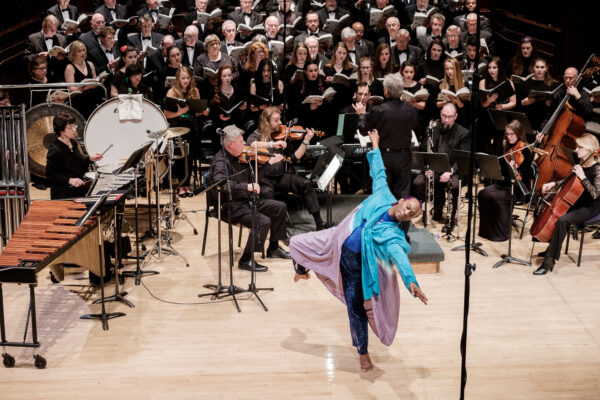
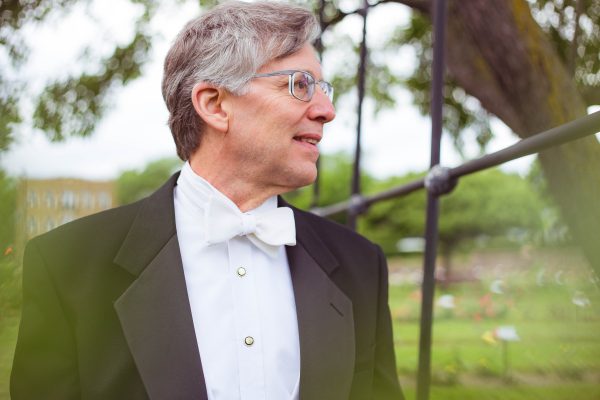
Eric Townell, Artistic Director
Eric Townell became the third music director of the Rochester Oratorio Society in 2006. An international award-winning conductor of opera, choral and orchestral repertoire, Eric has been a frequent guest conductor for the Rochester Philharmonic Orchestra. He has led professional productions nationwide and internationally for the past three decades. Eric previously held artistic posts in Milwaukee, Madison and Stevens Point, Wisconsin, and served as Artistic Director of Rochester Lyric Opera for four seasons. Eric is concurrently Artistic Director of the Finger Lakes Choral Festival. He is the host of “In the Spotlight,” produced and distributed statewide by Penfield Television.
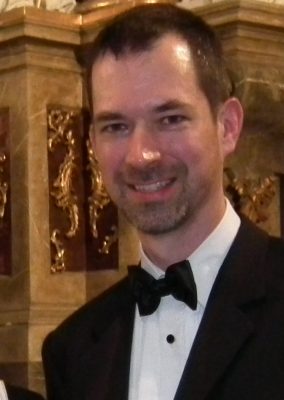
Kevin Nitsch, Accompanist
Kevin Nitsch is a pianist, collaborator and teacher in the Rochester area. Kevin is a member of the piano faculty at Nazareth College of Rochester, is vocal coach at SUNY Geneseo and is the Music Director at the Baptist Temple in Brighton. Kevin performs regularly with Rochester Oratorio Society, Finger Lakes Opera, and Lyric Opera. In celebration of Beethoven’s 250th birth year, Kevin anticipates performing the five piano concertos in the Fall of 2020.
Kevin holds a BM in Piano Performance from the University of Missouri-Kansas City Conservatory of Music, and a MM and a DMA in Performance and Literature in Piano Performance from the Eastman School of Music.
Kevin lives in Penfield with his wife, Brenda and enjoys hiking, biking and kayaking. He is a certified yoga instructor and finds pianobenchasana to be his favorite pose.

ROS CHORUS
Sopranos
Sara Anthony
Tania Beghini
Barbara Bissell-Erway ♪
Rachel Boucher
Elizabeth Brault
Laurel Buckwalter
Miriam Cowans
Luanne Crosby
Karen Crummins
Lisa deBlieck ♪
Karen Dey ♪
Amy Ewell ♪
Nancy Fink
Paulette Gissendanner
Alayne Gosson-Kane ♪
Liane Grasso
Lilith Hart ♪
Meredith Hart
Shari Holzer ♪♪♪♪♪
Cora Jackson ♪♪♪
Rebecca Johnson
Beth Keefer
Jane Keller
Yasuko Kelly
Katelyn Kochalski
Katie Kovacs (Choral Scholar)
Jo Ann Lampman ♪♪♪♪♪
Annette Leopard
Francine McAndrew
Leta Mueller ♪♪♪
Mary Ann Nazzaro ♪♪♪
Susan Reindel
Ann Robinson ♪
Elise Rosenfeld ♪♪♪♪
Katherine Schumacher ♪♪♪
Maura Slon
Kelly Smeltzer
Beal St. George
Jessica Steidle
Rachel Stuart
Cynthia Towler
Arlene Vanderlinde ♪♪
Vicky Wadsworth
Katherine Walter ♪
Wendy Willis ♪
Denise Yarbrough
Altos
Debbie Loo Anderson ♪♪
Dianne Bailey
Riley Blaakman
Lynn Brussel ♪♪
Donna Budgeon ♪
Nancy Cangiano ♪♪♪
Jane Capellupo ♪♪♪♪♪
Jenifer Cheney ♪
Mary Ellen Coleman
Carol Elliott ♪♪♪♪♪
Sarah Engel
K. Sue Geier
Maryellen Giese ♪♪
Kathleen Green ♪
Barbara Hellwig ♪♪♪
Jenny Horn ♪
Carole Huther ♪♪♪
Lois Johnson
Lisa Klein ♪♪♪
Nina Koski
Grace Leung
Anna Lieser
Sue Lione
Caitlin Maeder
Honey Meconi
Sandy Moncrief
Dorothy Needler ♪
Janis Pavia
Virginia Payne ♪♪♪
Patricia Sanborn ♪♪♪
Molly Sanchez ♪
Nancy Schreiber ♪
Elizabeth Seely
Grace Seiberling ♪
Mary Avis Seitz
Robin Townell ♪
Monica Tyne
Patricia Van Dussen ♪♪♪
Betty Wells ♪
Jenessa Wheeler
Susan Woodhouse
Tenors
John Buckwalter
Evan Burnett
Shawn Cox
MingRen Huang (Choral Fellow)
Frederick Jefferson
Richard Johnson
Greg Madejski
Daniel McInerney ♪♪
Charles Meyer ♪
Jeff Moran
Alex Nick (Choral Fellow)
Simone Picciolo ♪♪
Jeffery Snarr
Keith Van Nostrand
Patrick Walter ♪
Samuel Wersinger
Virginia Wohltmann ♪♪♪♪
Basses
Brandon Bartlett
Alan Bartlow, Sr. ♪♪
Robert Booher
Philip Burke
Timothy Coleman
Douglas Constable ♪♪♪♪
Stephen Crandall
Peter Gaess ♪
Scott Griswold
Christian Haller ♪♪
Harry Hellwig ♪♪♪
Stanley Jones
Roy Kirvan
Robert Leopard
Eric Logan
Louis Malucci
Richard Moncrief
Luciano Pagano (Choral Scholar)
David Prener
Andrew Schep
Robert Slon
Steven Smith ♪♪
Rob White
Ted White
Ben Willmott
Jeffrey Wright ♪♪
___________
10 Year Member ♪
20 Year Member ♪♪
30 Year Member ♪♪♪
40 Year Member ♪♪♪♪
50 Year Member ♪♪♪♪♪
ROS ORCHESTRA
David Hult, Concertmaster
Margaret Leenhouts, Second Violin
Joanne Lowe, Viola
Joan Kinsella, Cello
Humberto Colon, Db Bass
Diane Smith, Flute l
Judith Ricker, Oboe l
Margaret Quackenbush, Clarinet l
Martha Scholl, Bassoon l
Jonathan Dozois, Horn l
Kevin Smith, Keyboard
Kristen Shiner McGuire, Timpani
Tom Nanni, Percussion l
Kevin Nitsch, Keyboard
ROS BOARD OF DIRECTORS – OFFICERS
Sue Geier, President
Jeff Moran, Vice President
Daniel McInerney, Secretary
Nina Fargnoli, Treasurer
BOARD MEMBERS
Phillip Burke
Jenny Horn
Carole Huther
David Prener
Katherine Clark Walter
Ben Willmott
STAFF
Eric Townell, Artistic Director
Matt Bevan-Perkins, Office Coordinator
Jo Ann Lampman, Registrar
Kathleen Green, Financial Operations Manager
COMMITTEE CHAIRS/KEY VOLUNTEERS
Choral Scholars and Choral Fellows | Maryellen Giese
Development Committee | Jenny Horn
Education and Community Outreach | Molly Sanchez
Event and Fundraising Committee | David Prener
Executive Committee | Sue Geier
Finance Committee | Nina Fargnoli
Governance Committee | Carole Huther
Marketing and Public Relations Committee | Sarah Stage
Membership Committee | Katherine Clark Walter
Production Management Committee | Donna Budgeon/Patrick Walter

Play YOUR part in the Rochester Oratorio Society
The Rochester Oratorio Society invites you to join us in helping to ensure our continuing legacy of providing audiences with high quality live choral music through support of the ROS Endowment at the Rochester Area Community Foundation.
The ROS Endowment provides significant income each year to support current operating costs. Cash donations to the Endowment in any amount are always welcome, or donate directly to the ROS Endowment via the Rochester Area Community Foundation web site at www.racf.org.
Planned gifts to The Rochester Oratorio Society are a wonderful way to strengthen our organization today, while providing you, our donor, with options that fit your wealth management plans. A planned or deferred gift, along with the accompanying benefits to you, is arranged during your lifetime, but the gift to the Rochester Oratorio Society is deferred to a future date. The most common planned gift is a bequest, which allows you to make a significant contribution that may not be possible during your lifetime, and protects your family, loved ones, and the organization you care about.
The Rochester Oratorio Society Notable Guild recognizes those loyal and generous music lovers who have chosen to include the Rochester Oratorio Society in their bequests or other long-range charitable giving plans. By including ROS in your will and becoming a member of the Notable Guild, you are giving the joy and inspiration of great choral ensemble music to Rochester’s future generations.
To inform the Rochester Oratorio Society of your gift, or for additional information, please request our endowment brochure, call us at (585) 473-2234, or learn more at: https://rossings.org/support-ros/planned-giving/
Patrons
This listing acknowledges donations received January 1, 2022 to September 30, 2022.
Thank you for your support!
Production Sponsor ($1000 and above)
Jane Capellupo
Carol Elliott
Mark & Linda Hopkins
Karen Kral
Elise Rosenfeld
Jon & Kathy Schumacher
Enterprise Sponsor ($250 – $499)
Kathleen Barbehenn
Suzanne Gouvernet
Kathleen & Russ Green
Roc Insurance Services, Inc.
Mr. and Mrs. Christian Haller
Adrian & Jennifer Horn
Jeffrey Moran & Barbara Quine-Moran
Rollie Townell
Lauri VanHise
Patron Sponsor ($100 – $249)
Anonymous
Susan Basu
Robert Booher
Donna Budgeon
Katherine Ciesinski
W.J. Clicquennoi
Mary Ellen & Timothy Coleman
Mary DeMarsh
Maryellen Giese
Shari Holzer
Karin Kaminker
Rose-Marie B. Klipstein
Jo Ann Lampman
Daniel & Pamela McInerney
Virginia Payne
David & Susan Prener
Jon & Kathy Schumacher
Eric Townell
Monica Tyne
Vicky Wadsworth
Program Sponsor ($500 – $999)
K. Sue Geier
Sandy & Richard Moncrief
Mary Ann Nazzaro
John Ninfo II
Thomas & Jeanne Verhulst
Ben & Kristen Willmott
Virginia Wohltmann
Betty Wells & Jeffrey Wright
Rehearsal Sponsor ($50 – $99)
Kathleen Cloonan
Mary Ellen Coleman
Robert Crystal
Mary Anne Guariglia
Diane & Ed Hoener
Carole Huther
Jack & Paula Mansur
Dorothy Needler
Gary Rossi
Patricia Sanborn
Nancy Schreiber
Ms. Kate Shannon
Sarah Stage
Music Sponsor ($10 – $49)
Dianne Bailey
Karen Dey
Sarah Engel
Scott Griswold
Linda Haynes
Pru Kirkpatrick
Ruth Mance
Ms. Leta Mueller
Ms. Rosemary Zuck Mummert
Joan O’Brien
Patricia Van Dussen
Lewis B. Ward-Baker
Susan Woodhouse
In Honor Of
Elise Rosenfeld, given by David & Andrea Golub
In Memory of
Ann Parsons, given by Sharon Dickman
David & Elizabeth Husung, given by Roy Husung
Arvid Lakeberg, given by Jack & Paula Mansur
Katie McNally, given by Frederick Merk
Esko Townell, given by Rollie Townell

